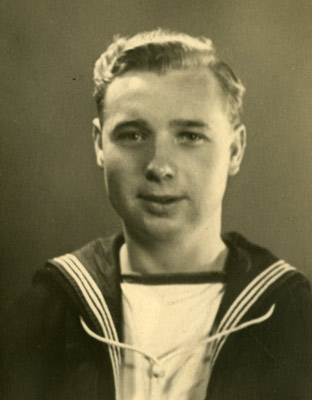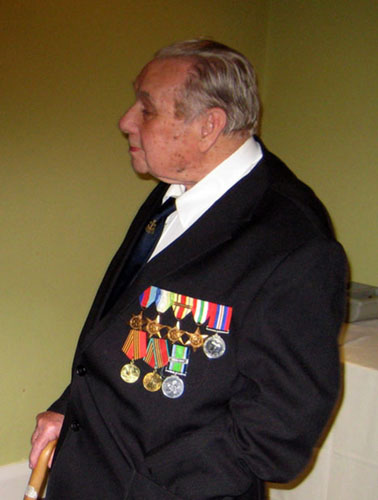







 Frederick N.G. Thomas, known to his shipmates as "Freddo", died on
Wednesday 9 May 2012 after a short illness aged 92. The son of a miner
he
was born in the coal mining valleys of South Wales in 1920 and was a
student at
Monmouth Teacher Training College in Caerlion when he received his
call-up papers and volunteered to join the Royal Navy.
Frederick N.G. Thomas, known to his shipmates as "Freddo", died on
Wednesday 9 May 2012 after a short illness aged 92. The son of a miner
he
was born in the coal mining valleys of South Wales in 1920 and was a
student at
Monmouth Teacher Training College in Caerlion when he received his
call-up papers and volunteered to join the Royal Navy.
He trained as an
RDF Operator at HMS Ganges
(February - March 1940), formerly a school for boy sailors. The POs
were accustomed to using harsh discipline, including the lash, but
grown men called up for service in the RN hit back. Fred and two other
representatives pointed out to the CO that corporal punishment had been
banned in the RN since Victorian times and the POs deserved what they
got. This was accepted.
Fred joined HMS Venomous at Portsmouth after Dunkirk and was at Harwich when invasion was expected and at Londonderry escorting Atlantic convoys. He rescued the ship's crest when it was put aside with other "rubbish" for disposal during the refit after the collision with HMS Keppel (only to have it stolen from his garage after the war) and took part in Arctic convoy PQ.15 to Murmansk and Operation Pedestal to relieve Malta. He describes events when HMS Hecla was torpedoed off the coast of North Africa on Armistice Day 1942 when Venomous rescued 500 survivors (three are still alive in 2018).
Freddo was a keen photographer and many of the pictures he took aboard HMS Venomous with his Ensign Box camera are included in A Hard Fought Ship and help give a real sense of what it was like to serve on a V & W Class destroyer during World War II. His description of life as a rating on the lower deck of HMS Venomous was quoted extensively in the second edition of A Hard Fought Ship but has not until now been published in its entirety.
*****************
Life on board for ratings was very hard and made much worse by mess-deck accommodation being totally inadequate. On a single mess-deck, below the main deck, there were usually two messes, one on the starboard side and one on the port. The starboard mess was home to fourteen communication-ratings, W.T. operators and, signalmen, while on the port side were the torpedo men’s mess occupied by the depth-charge crew and the torpedo-men. For four years, I was the only R.D.F. operator (an early form of Radar) and lived in this mess. The R.D.F. cabin was on the superstructure above, and abaft the bridge, and very exposed to the cold, bullets and shrapnel.
Both messes had about 14 or 15 seamen each, and the meals were prepared and served and cleared away by the system of “mess-deck catering”. Two men from each mess served as “cooks of the mess”. Their job for a day was to prepare the ingredients for the meal, take it up to the galley, and hand it over to the galley cook.
The galley cook's job was merely to see that the various meals did not burn or dry out. In the small ships, weekly duty as “cook of the mess” was in addition to all other duties. When the pipe “cooks to galley” was sounded about midday, the two sailors on duty went to the galley to pick up the mess meal, usually contained in a large metal tray with two very hot handles which were wrapped in dish-clothes. One cook of the mess carried the meal to the hatch leading down to his mess-deck. His partner went ahead and descended halfway down the metal ladder to take hold of the tray when it was lowered. When the sea was rough, a third mess-mate was required to steady the one on the ladder by placing his hands firmly on his mate s buttocks.
It was a dangerous procedure, which sometimes ended with the very hot contents of the tray falling on the head of one of the men. To suffer bodily harm from the constituents of a meal was not always accidental for the “ cook of the mess”, as my own experience testified. The leading seaman of the mess decided on pancakes for “afters”. Neither I, as cook, nor my mate, had the slightest idea how to make them. We experimented with a stiff mixture of flour, milk and butter and tossed the hard round rubbery discs! When these were served they were quite inedible, so our shipmates pelted us with them – very forcibly! Shrove Tuesday always brings back the memory.
Venomous was an old ship and when the war began did not have anti-aircraft guns, R.D.F. and other modern weapons. Consequently, her crew, including officers, numbered about 120. During the first year of the war modernisation slowly progressed and her crew began to increase in numbers but there was no commensurate increase in the number of hammock spaces on the lower deck to accommodate the extra men. I, for one, had to wait six months before a hammock sling became available. Meanwhile, I had to sleep on the lockers on the seaward side of the mess-table, lashed to the bars of the boot-rack, or I should have rolled off the lockers and under the mess-table! Somehow, I accustomed myself to this, but I could never good-humouredly tolerate being woken up by a mess-mate who needed to obtain a duffel coat or gloves from the locker directly beneath me.
One or two of the older ‘salts’ having enjoyed their neat tots of rum before a meal seemed to spear a piece of meat, raise it to their cheeks first, before finding their mouths with difficulty. The tales they told about lurid shore-leave incidents, real or imagined were extremely entertaining.
One
thing that was hard for me to endure on the mess-deck was the smoking
of leaf-tobacco. An old custom allowed seamen to buy leaf-tobacco on
board. A method of converting it to a smokeable form was to roll it
into “pricks”. The leaves were rolled into sausage-like shapes,
sprinkled with neat rum and bound up tightly with thick string. One end
of the string was then tied to one of the hammock bars and the other
end to another bar, so that it hung loosely two or three feet from the
deck. The seaman then squeezed the “sausage” by sitting on it with a
leg either side and raising and lowering himself. The finished product,
after drying, could then be flaked into a smoking pipe a number of
times.
Another unpleasant smell in the mess was that of unwashed bodies. Fresh
water was only available for cooking and drinking. Salt water soap was
supplied but this produced no lather. There were no baths or showers
available for lower-deck ratings and only four wash-basins at the break
of the forecastle on the upper deck, exposed to the cold wind. The
usual practice was to fill a bucket with water and pour it over the
head and body. Not too bad if the water was warm and fresh, but often
it was not. If fresh water was in short supply and needed by the ship’s
boilers and machinery, the only solution was to tie a bucket to a rope
and drop it over the side, then haul it up filled with cold sea water –
a forbidden practice – which was very dangerous if the ship was
moving at more than a few knots. In contrast, if the cook of the mess
did not empty it overboard quickly enough the “gash-bucket” containing
meal refuse and sometimes vomit, tipped up and spread its contents over
the deck…
In the North Atlantic winter the wind and the enormous waves were a great problem, especially for the west-bound convoys (i.e. the “empties”). The convoys followed an agreed route, thought to be the safest from U-boat attacks but this route was not always the best in relation to the huge waves that had built up over hundreds of miles. A ship, large or small, generally steers into the storm. Small escort ships like “Venomous” (only one-fifth the size of the average merchant ship), were unable to do this, without breaking the escort defence pattern. The result was that Venomous often steered into the waves at a slanted angle, causing dangerous side to side rolling, as well as the pitching motion, when the bows protruded almost vertically above the sea before crashing down into a deep hollow.
Water raced the full length of the upper deck, making it extremely dangerous for crew members to move about. To reduce the danger of being swept overboard a steel wire was secured from one end of the deck to the other with thick sliding hand-ropes but on one occasion a seaman moving to his station was washed overboard. To the dismay of his shipmates, and particularly of the captain, the ship had to move on. To stop and attempt a rescue would have been futile and exceptionally hazardous. On several occasions the sea was so rough that almost everyone on board, including the old “salts” were seasick.
"Freddo" left HMS Venomous at Falmouth in October 1943 and was sent for officer training at HMS Victory in Portsmouth and at HMS King Alfred, Lancing at Hove. Sub Lt F.N.G. Thomas RNVR was posted to the cruiser HMS Sirius as HA Gunner in October 1944. In 1946 he was second in command of the mine sweeping trawler HMS Lord Irwin
en route to the Far East via Suez but was ordered back home when Japan
surrendered. Freddo gave a hilarious account of the problems caused when
the crew of former fishermen went ashore in Spain, got drunk and stole
some policemen's helmets leading to their arrest by Spanish soldiers
to the immense annoyance of the British Consul.
"Freddo" taught at a school in north London before joining the staff of
the London Nautical School. He studied part time at the London School of
Economics for a degree and an MSc on Portsmouth and Gosport: the Historical Geography of a Naval Port
(his supervisor wanted him to re-submit his thesis for a PhD but family commitments made this impossible) and was
appointed as Principal
Lecturer in Geography at the College of All Saints, a teacher training
college, now part of London University, and retired in 1981 as a
Reader. He married Violet Gilham in 1951 and they had two daughters.